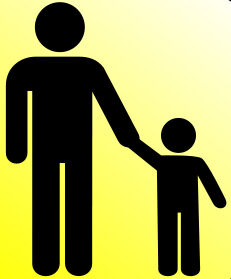Attention
8 Secrets of Competent Childrearing
It takes as much work to raise a person right as it does to raise them wrong.
Posted September 20, 2021 Reviewed by Kaja Perina
Key points
- Parental instincts are strong but require additional formal guidance.
- All young children and new parents go through normative phases as part of biological maturity and psychological socialization.
- Parents have more influence on children in smaller single-generation families than in previous generations when older kids helped raise siblings.

The need for child rearing resources.
Cars come with an operating manual, but a baby does not. How strange. Parents need a training manual about things that should come "naturally" but don't.
Raising a human being is hard work. Benjamin Spock's, The Common Sense Book of Baby and Child Care was initially published in 1946 to help post-WWII parents be the "doctor on call" to raise a child during the Baby Boom. My parents were in that group. I was the guinea pig.
The "common sense" adjective in the title was later deleted, since by definition, if such a book were needed, and common sense is innate, there would be no need for such a book. Since 1946 the books, with multiple new authors, have sold over 55M copies as proof of concept that parents need professional aids with smaller families and absent grandparents.
A crash course in developmental psychology and learning.
Here are some basic suggestions for new parents I have used in my practice over the year in family counseling. Be consistent and fair. When things don't seem right, when your child is acting up or odd, always wonder why and how the behavior developed.
Even “experts” have problems changing behavior sometimes. Catch children being good and make sure they know why. Children cry out for guidance and for discipline. They want structure. They want limits and will test them to assess if you care.
Teach by example, and learn by doing. Never ask a child to adhere to abstract principles that are impossible to practice in real life.
Remain optimistic and realistic using expectations based on neurological and cognitive development. Don't expect a seven-month-old to be toilet trained or expect a six-year-old to use adult common sense. Basic knowledge of childhood development makes parenting more manageable and more effective.
The 8 common developmental behaviors in very young children.
The most common developmental behaviors in very young children are crying, illness, dropping and throwing items, separation anxiety and school phobias, the spoiled child, thumb sucking, and abuse of comforters. These eight childhood behaviors sound innocent enough, but when a new parent can drive you bonkers.
1. Crying
We were in a fancy hotel eating dinner. A large family sat down at the next table over and asked the waiter for a high chair. The child screamed the entire time, ruining the atmosphere of the special occasion. The mother's parents ignored the crying. Other guests were similarly peeved.
The behaviors of complaining, throwing tantrums, and frequent crying all have something in common. They are directed at the parents and are at least, in part, maintained by attention from the parents.
In the case of crying, however, some physical aspects of the situation increase or decrease its frequency. A kitchen chart can come in handy at this point. Keep a record of when crying occurs and note the reasons for it. You may already suspect that part of the crying results from fatigue late in the day or being used on particular persons in the family and or occurs only when they are around.
2. Illness
When a youngster becomes ill, the rules by which he receives attention usually change. The demands that the child does things on his own and take care of himself are reduced. If your child learns that he will receive advantages whenever he says he is ill, you are in trouble. There will be references to illness that you cannot verify-a headache, an arm ache, or an upset stomach--are complex claims to check out. The child may not even tell that he is exaggerating and honestly believes he is sick. It is usually difficult for a parent to deny that a child is not ill.
3. Dropping and Throwing Objects
Dropping and throwing objects are similar to crying because they can all be considered attention-getting behaviors. A child who throws his spoon from his highchair or drops a full glass of milk has found an effortless way to get his parents (or mother, as is usually the case) to pay a little bit more attention to him while he eats. Again, the focus must be on good behaviors that will receive attention and eliminating nasty and annoying behaviors that maintain negative attention.
4. 5. School phobia and separation anxiety.
These conditions can develop into a “school phobia” and separation anxiety. First, love and attend to the child for good reasons. Second, deemphasize praise when ill if you believe it is causing school phobia. Third, be creative and see what happens. For example, if the child claims he has a headache, perhaps your first response should be that he lie down and take a nap rather than watching television instead of doing homework.
6. The spoiled child
Parents may suspect that some of their child's bad behavior occurs because of the attention it attracts. The first step toward seeking a solution should be to ask, “Why can't my child get the attention he needs through other behaviors?”
One answer might be that the child does not receive attention or consideration in family activities until he draws attention to himself for being emotional. In other words, he has settled on this solution for getting what he wants because there are no other solutions.
A second answer, which is probably more generally true, is that other solutions provide some considerations, but the overall amount of attention he receives is small, and he receives more attention for destructive behaviors than good ones. In short, a spoiled child has found a way to control his parent's behavior.
7. 8. Thumb sucking and comforters.
Thumb-sucking and overt use of comforters, such as blankets, tends to be an attention-getting device. If used in this way, the strategy should include the designation of good behaviors that will be attended to and an extinction procedure (ignoring what you want to go away) for the thumb-sucking behavior.
No one seems to mind a one-year-old carrying around his favorite blanket, but as a child reaches his third or fourth birthday, this behavior can become a problem. As young children mature, you must always ask if the behavior is age-appropriate and not judge the behavior as an end in itself.
The second alternative for the removal of the comforter is to present some enforceable “fading” technique. You might start by limiting when the comforter will be available. You insist that from the time the child gets up in the morning until, for example, at 7:30 a.m., he may not have the comforter, but after that time, he may. You may establish the time at 8:00 a.m. in the second week, then increase the interval daily, but always beginning with the early part of the day, when he is rested.
The art (and exhaustion) of parenting.
All new parents experience these childhood behaviors as minor, transient problems within developmental phases. Never punish a child for these choices. They are evolutionary, biological, and acquired. Don't fret. Most kids turn out fine. And parents, yes, you need a night out once in a while.
References
Spock, B. (1946). The Common Sense Book of Baby and Child Care: With illustrations by Dorothea Fox, New York. Duell, Sloan and Pearce.
Center on the Developing Child. Harvard University. (2021) www.developingchild.harvard.edu




